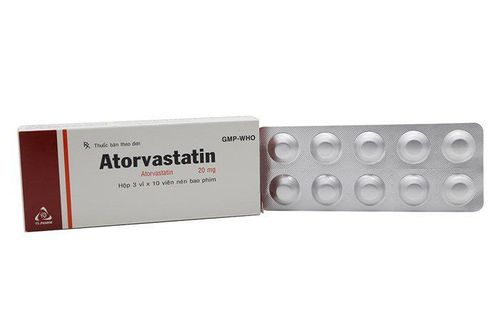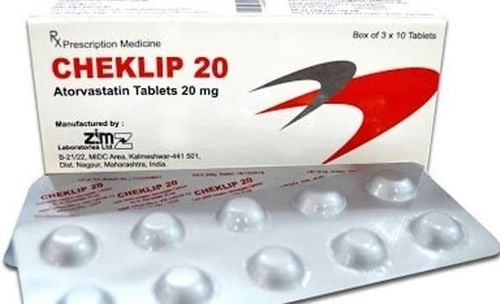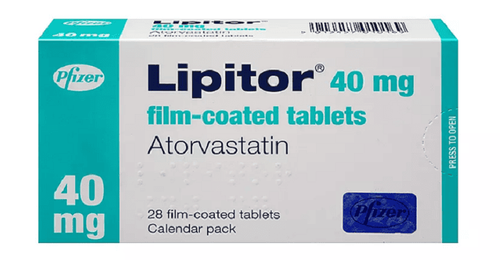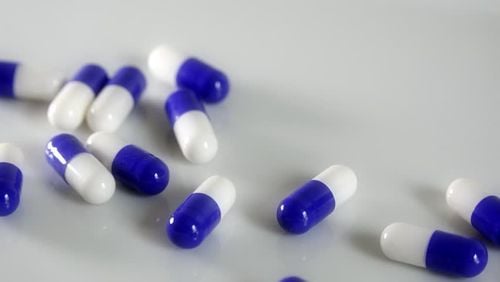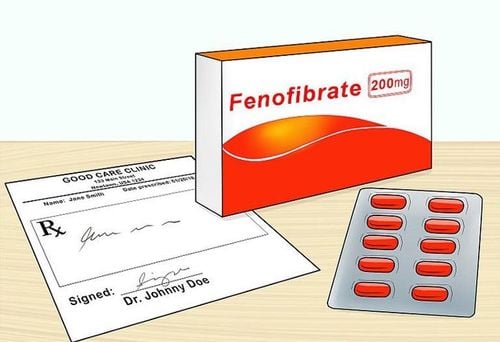This is an automatically translated article.
Before prescribing Lipidtab, the doctor should instruct the patient on a standard cholesterol-lowering diet and maintain this diet throughout the treatment period. What is Lipidtab?
1. What is Lipidtab?
The main ingredient in Lipidtab is Atorvastatin calcium trihydrate, equivalent to Atorvastatin 10mg (Lipidtab 10) or 20mg (Lipidtab 20). Lipidtab 20 is a film-coated tablet containing an active ingredient system including: Calcium carbonate, Lactose monohydrate, Microcrystalline cellulose, Povidone K30, Polysorbate 80, Croscarmellose sodium, Magnesium stearate, Talc, Titanium dioxide, Hydroxypropyl methylcellulose, Polyethylene glycol 4000.2. Uses of Lipidtab 20
Indications for use of Lipidtab 20 to treat hyperlipidemia: Atorvastatin is indicated for use as an adjunct to diet to reduce total cholesterol, LDL-C, apolipoprotein B and triglycerides, and increase HDL-Cholesterol in patients with primary hyperlipidemia, mixed hyperlipidemia, heterozygous familial hypercholesterolemia; Lipidtab 20 drug supports the treatment of patients with hypertriglyceridemia and beta-lipoproteinemia who do not respond adequately to diet; Atorvastatin contained in Lipidtab 20 is also indicated for the reduction of total cholesterol and LDL-C in patients with homozygous familial hyperlipidemia as an adjunctive agent or when other therapeutic measures are not available. doable; Prevention of cardiovascular events in patients at high risk for first-time cardiovascular disease, as an adjunct to the treatment of other risk factors.
3. Dosage of Lipidtab 20
Lipidtab 20 starting dose and maintenance dose need to be individually adjusted for each patient based on the goal of treatment and the patient's ability to respond. The usual starting dose of Lipidtab is 10 mg (1 Lipidtab 10 tablet) once daily with dose increments of at least 4 weeks. The maximum dose of Atorvastatin is 80 mg once daily. Atorvastatin can be taken in all doses in one dose, at any time of day, with or without food.
Hypercholesterolemia (heterozygous familial or non-familial), mixed dyslipidaemia (Fredrickson class IIa and IIb): The recommended starting dose of Lipidtab for Atorvastatin is 10 mg. 1 Lipidtab 10 tablet) or 20mg (1 Lipidtab 20 tablet), once a day. Patients requiring significant cholesterol reduction (target reduction of more than 45 %) can be initiated at a dose of 40 mg Lipidtab once daily. The therapeutic dose range of Atorvastatin is 10 - 80 mg, once a day. Homozygous familial hypercholesterolemia: The therapeutic dose of Lipidtab is 10 - 80 mg per day. Lipidtab should be used in combination with other lipid-lowering measures (e.g. LDL apheresis). Cardiovascular Event Prevention: Initial dose of Atorvastatin is 10 mg/day; higher doses of Atorvastatin may be needed to achieve LDL cholesterol levels according to current guidelines. Dosage of Atorvastatin in Renal Impairment: Renal disease did not alter the concentration of Atorvastatin nor the LDL cholesterol-lowering effect of Atorvastatin. Therefore, there is no need to change the dose of Lipidtab in patients with renal impairment. Dosage of Lipidtab in patients with hepatic impairment: Atorvastatin should be used with caution in patients with hepatic impairment. Atorvastatin is contraindicated in patients with advanced liver disease. Use of Atorvastatin in the Elderly: The efficacy and safety of Atorvastatin in adults over 70 years of age is similar to that of Atorvastatin in the general population. Use of Atorvastatin in Pediatric Patients: To be performed only by physicians experienced in the treatment of hyperlipidemia, patients should be reevaluated on a regular basis to review progress. For patients 10 years of age and older, the recommended starting dose of Atorvastatin is 10 mg daily, possibly up to 20 mg Atorvastatin daily. Dosage increases of Atorvastatin should be based on individual response and tolerability of Atorvastatin in pediatric patients. Atorvastatin is not indicated in the treatment of patients < 10 years of age. Should choose another drug more suitable for this object.
4. Combination therapy Lipidtab
Lipidtab drug can be considered in combination with the following drugs:
Lipidtab drug can be used in combination with resin to increase the effectiveness of treatment; Combination therapy with HMG-CoA reductase inhibitors such as Lipidtab and fibrates is not recommended. Precautions when prescribing Atorvastatin in combination with HIV and HCV protease inhibitors are as follows: Lopinavir + Ritonavir: the lowest dose of atorvastatin should be used. Darunavir + Ritonavir, Fosamprenavir + Ritonavir, Fosamprenavir + Ritonavir or Saquinavir + Ritonavir: Not to exceed 20 mg of Atorvastatin daily. Nelfinavir: Do not exceed 40 mg of Atorvastatin per day.
5. Contraindications of Lipidtab
Contraindications of Lipidtab drug in the following cases:
Patients with hypersensitivity to Atorvastatin or any component of Lipidtab drug; Patients with progressive liver disease or unexplained, persistently elevated serum Aminotransferase levels; Pregnant women, nursing mothers, suspected pregnancy, women of childbearing age who do not use contraception.
6. Note when using Lipidtab
During the use of Lipidtab, the following issues should be kept in mind:
Before starting treatment with statins, the doctor needs to determine the cause of hypercholesterolemia and measure lipids to confirm determine the dose of Lipidtab for treatment; Conduct periodic blood lipid measurement, at intervals of not less than 4 weeks, to adjust the dose of Lipidtab drug according to the patient's response to the drug; 6.1. Hepatic Effects Moderate increases in serum transaminases (>3 times upper limit) have been observed following treatment with Atorvastatin. Persistent elevations in serum transaminases (>3 times the upper limit on at least 2 assays) occurred in 0.7% of patients receiving Atorvastatin. The frequencies of these abnormalities were 0.2%, 0.25%, 0.6% and 0.35% for the 10mg, 20mg, 40mg and 80mg doses, respectively. When the dose of Atorvastatin is reduced, treatment is interrupted or discontinued, transaminases will return to pre-treatment levels, without sequelae.
Liver enzyme tests should be performed before starting Lipidtab therapy, liver enzymes should be monitored in patients with elevated transaminase levels, if ALT or AST increases more than 3 times and persists then Lipidtab dose should be reduced or atorvastatin discontinued. Lipidtab should be used with caution in patients who drink alcohol and/or have a history of liver disease. 6.2. Prevention of stroke due to drastic reduction in cholesterol levels In a trial analysis of people with recent stroke or transient ischemic attack, there was a high rate of hemorrhagic stroke in patients taking Atorvastatin initially. starting dose above 80 mg compared with placebo.
For patients with hemorrhagic stroke or anterior lacunar infarction, the risks and benefits of the Atorvastatin 80 mg dose are uncertain, and the risk of hemorrhagic stroke should be carefully considered before initiating treatment. start treatment with Lipidtab.
6.3. Effects of Lipidtab on Skeletal Muscle Myalgia has been reported in patients treated with atorvastatin.
6.4. Consider creatine kinase (CK) monitoring Before starting treatment with Lipidtab, a CK test should be performed in the following cases: Renal impairment, hypothyroidism, personal/family history of hereditary myopathy, a history of statin or fibrate myopathy, a history of liver disease and/or alcohol consumption, and elderly patients (>70 years of age) are at increased risk for rhabdomyolysis.
6.5. Interstitial lung disease Several cases of interstitial lung disease have been reported in patients with long-term use of certain statin drugs. Manifestations include shortness of breath, dry cough, and deterioration of health.
6.6. Diabetes Statins can increase blood sugar and in some patients are at increased risk of developing diabetes in the future. However, this risk is not as severe as statins reduce cardiovascular risk, so diabetes is not a reason to discontinue statin therapy.
7. Side effects of Lipidtab
During the use of Lipidtab, patients may experience some of the following side effects:
Common: nasopharyngitis, hyperglycemia, increased HbA1c, allergic reactions, headache, sore throat - larynx , nosebleeds, constipation, flatulence, indigestion, nausea, diarrhea, myalgia, arthralgia, pain in the extremities, muscle spasms, joint swelling, back pain, abnormal liver function, increased blood creatine kinase up; Uncommon: hypoglycaemia, weight gain, anorexia, nightmares, insomnia, dizziness, abnormal sensations, decreased sensation, dysgeusia, cognitive impairment (amnesia, confusion, blurred vision) , tinnitus, vomiting, upper and lower abdominal pain, belching, pancreatitis, hepatitis, hives, skin rash, itching, hair loss, neck pain, muscle fatigue, fatigue, weakness, chest pain, peripheral edema, fatigue, fever, urine positive for leukocytes; Rare: thrombocytopenia, anaphylaxis, peripheral neuropathy, visual disturbances, cholestasis, angiogenic edema , bullous dermatitis including erythema multiforme, Stevens-Johnson syndrome and toxic epidermal necrolysis, myopathy, myositis, rhabdomyolysis, tendon pain, sometimes complicated by hernia; Very rare: hearing loss, liver failure, gynecomastia in men.
8. Lipidtab drug interactions with other drugs
Effect of concomitant medications on atorvastatin:
Strong inhibitors of CYP3A4 that increase concentrations of Atorvastatin: ciclosporin, telithromycin, clarithromycin, delavirdine, stiripentol, ketoconazole, voriconazole, itraconazole, HIV protease inhibitors Substances Moderate CYP3A4 inhibitors such as erythromycin, diltiazem, verapamil and fluconazole... may increase plasma concentrations of Atorvastatin. Concomitant use of Atorvastatin with cytochrome P4503A inducers such as efavirenz, rifampin... may reduce plasma concentrations of Atorvastatin. Protein transport inhibitors such as Cyclosporin may increase the systemic exposure of Atorvastatin. Ezetimibe: muscle problems, including rhabdomyolysis, are increased with concomitant use of Ezetimibe and Atorvastatin. Colestipol: Atorvastatin plasma concentrations are lower when Colestipol is co-administered with Atorvastatin. Effect of atorvastatin on concomitant medicinal products:
Digoxin: Atorvastatin increases plasma digoxin concentrations; Warfarin: Co-administration of Atorvastatin 80 mg daily with Warfarin caused a small decrease (approximately 1.7 seconds) of prothrombin time during the first 4 days of use and returned to normal within 15 days; Antacid: An infusion of antacid containing magnesium and aluminum hydroxide will reduce plasma concentrations of atorvastatin; Cholestyramine: Plasma concentrations of atorvastatin are reduced (approximately 25%) when co-administered with cholestyramine. Erythromycin: Concomitant administration of Atorvastatin with Erythromycin increases the plasma concentration of Atorvastatin. There is an increased risk of muscle damage when Atorvastatin is used with the following drugs:
Gemfibrozil/fibric acid derivative; Other fibrates lowering blood cholesterol; High dose niacin (> 1g/day); Colchicine ; HIV and HCV protease inhibitors. In summary, Lipidtab drug has the main ingredient is Atorvastatin calcium trihydrate, equivalent to Atorvastatin 10mg. The drug is indicated for the treatment of hyperlipidemia, hypertriglyceridemia, reduction of total cholesterol and prevention of cardiovascular events in patients at high risk of first cardiovascular disease.
Follow Vinmec International General Hospital website to get more health, nutrition and beauty information to protect the health of yourself and your loved ones in your family.




